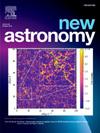Detection of CRSF in Cep X-4 at a low luminosity level
IF 2.1
4区 物理与天体物理
Q2 ASTRONOMY & ASTROPHYSICS
引用次数: 0
Abstract
The BeXRP Cep X-4 underwent a type II outburst during July 2023, during which NuSTAR made two observations of the source. In this paper, we present the spectral and timing analysis of Cep X-4 during this outburst. Pulsations were detected from the source at the neutron star spin period of 66 s from both observations. We detected a CRSF feature at an energy of keV in the spectrum of Cep X-4 during the first observation. In the second observation conducted a day later when the source luminosity dropped by a factor of five, no CRSF could be detected significantly. A positive correlation between CRSF energy and luminosity was observed using data from multiple outbursts since 1998. The collisionless shock model provides a good fit to the observed variations of cyclotron line energy with luminosity, giving a surface magnetic field strength of G.
低亮度水平下Cep X-4中CRSF的检测
BeXRP Cep X-4在2023年7月经历了一次II型爆发,在此期间,核星对源进行了两次观测。本文给出了Cep X-4爆发时的光谱和时间分析。两次观测都在中子星自旋周期为~ 66 s时从源处探测到脉动。在Cep X-4的第一次观测中,我们发现了能量为27.3−1.0+1.5 keV的CRSF特征。在一天后的第二次观测中,当光源亮度下降了五倍时,没有明显的CRSF检测到。利用1998年以来多次爆发的数据观测到CRSF能量与光度正相关。无碰撞激波模型很好地拟合了观测到的回旋加速器线能量随光度的变化,给出了表面磁场强度为~ 2.6× 1012 G。
本文章由计算机程序翻译,如有差异,请以英文原文为准。
求助全文
约1分钟内获得全文
求助全文
来源期刊

New Astronomy
地学天文-天文与天体物理
CiteScore
4.00
自引率
10.00%
发文量
109
审稿时长
13.6 weeks
期刊介绍:
New Astronomy publishes articles in all fields of astronomy and astrophysics, with a particular focus on computational astronomy: mathematical and astronomy techniques and methodology, simulations, modelling and numerical results and computational techniques in instrumentation.
New Astronomy includes full length research articles and review articles. The journal covers solar, stellar, galactic and extragalactic astronomy and astrophysics. It reports on original research in all wavelength bands, ranging from radio to gamma-ray.
 求助内容:
求助内容: 应助结果提醒方式:
应助结果提醒方式:


